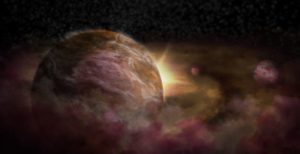
Three baby planets have been found in our own galaxy by pioneering scientists.
They are the youngest planets ever seen, and represent a discovery that is “at the frontier of science”. Researchers used a breakthrough new technique to find the newly-formed worlds around a young star relatively close to our own.
They now hope they can find yet more of the strange worlds, using the same technique. And the discovery could shed lights on how planets form at their very earliest stages.
Thousands of exoplanets have been discovered already, largely using the Kepler space telescope, which watches for the dips of light that they cause as they pass in front of their star. But protoplanets of this kind cannot be found using those techniques.
“Though thousands of exoplanets have been discovered in the last few decades, detecting protoplanets is at the frontier of science,” said Christophe Pinte of Monash University in Australia and lead author on one of the two papers.
The scientists found the planets by looking out for disturbances in the gas-filled disk around the star. They looked for a particular kind of light that is emitted by the movement of carbon monoxide – which allows them to understand how the gas in the disk is churning around.
If there were no planets in the disk, then the gas would move with a simple, predictable pattern. But unusual movement would seem to suggest there is some large body there.
“It would take a relatively massive object, like a planet, to create localized disturbances in this otherwise orderly motion,” said Pinte. “Our new technique applies this principle to help us understand how planetary systems form.”
They saw three of those disturbances, each of which is thought to be caused by a different planet.
There are other potential explanations for the strange data coming back from the star. But the new findings are the strongest evidence yet that there are new worlds forming in our own galactic neighbourhood.
The discovery was made by analysing images sent back from highly-powered telescopes pointing deep into the galaxy, in a way never done before.
“We looked at the localised, small-scale motion of gas in the star’s protoplanetary disc. This entirely new approach could uncover some of the youngest planets in our galaxy, all thanks to the high-resolution images from ALMA,” said Richard Teague, an astronomer at the University of Michigan and principal author on the other paper.


